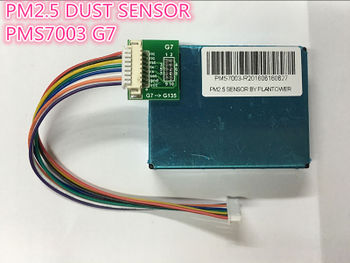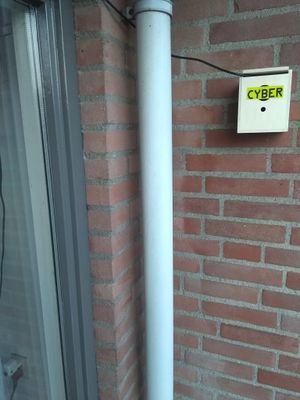DustSensor: Difference between revisions
(regelgeving) |
|||
| Line 292: | Line 292: | ||
De regelgeving voor fijn stof (PM10) kent twee doelstellingen: | De regelgeving voor fijn stof (PM10) kent twee doelstellingen: | ||
- Een grenswaarde voor het jaargemiddelde: 40 µg/m3 als jaargemiddelde mag niet worden | - Een grenswaarde voor het jaargemiddelde: 40 µg/m3 als jaargemiddelde mag niet worden | ||
overschreden. Aan deze grenswaarde moet sinds 2005 worden voldaan. Behoudens | |||
‘derogatie’ zijn geen uitzonderingen mogelijk (->Derogatie). Deze grenswaarde beoogt | |||
vooral bescherming te bieden tegen de langetermijneffecten van fijn stof. | |||
- Een grenswaarde voor het daggemiddelde: 50 µg/m3 als daggemiddelde mag op niet meer | - Een grenswaarde voor het daggemiddelde: 50 µg/m3 als daggemiddelde mag op niet meer | ||
dan 35 dagen per jaar worden overschreden. 5 Aan deze grenswaarde moet sinds 2005 | |||
worden voldaan. Behoudens ‘derogatie’ zijn geen uitzonderingen mogelijk (->Derogatie). | |||
Deze grenswaarde is vooral bedoeld om bescherming te bieden tegen de | |||
kortetermijneffecten van fijn stof. | |||
Revision as of 10:31, 17 March 2018
| Project Dust Sensor | |
|---|---|

| |
| Experiments with a dust sensor | |
| Status | Completed |
| Contact | bertrik |
| Last Update | 2018-03-17 |
Introduction
To get an idea of the levels of fine dust around my house, I ordered a dust sensor module to play around with. In particular, I ordered this one, the Plantower PMS 7003, AliExpress link. It's being advertised as an advanced generation of dust sensor (7th generation), while still reasonably priced (E15,-). It uses a laser to perform the measurement and it contains a small fan to move the air around.
In parallel with the fine dust level measurement, my device also measures basic meteo data using a BME280 module: temperature, relative humidity and air pressure.
I recommend to also get the cable converter board. The pitch of the connector on the sensor module is slightly non-standard: 2 x 5 pins with a spacing of 0.05 inch (instead of the common 0.1 inch spacing).
The data produced by this sensor is sent as JSON to a MQTT server. From there it is picked up by two protocol converters: 1) the Telegraf plugin to insert it into my own influx db and 2) a custom written Java application to forward it to the RIVM samenmeten website
Future work
Next steps:
- make it possible to support more than 1 sensor, e.g. also sensors from friends. Like making a distinction between individual sensors using the MQTT topic where the data is published.
Results
Below is a graph of the dust levels around new years eve 2017/2018, separated by particle size
You can clearly see a peak just after midnight.
See also the map of these two experiments:
Hardware
Data sheets can be found:
The module takes 5V to run and communicates using 3.3V levels. I connect it using a NodeMCU.
The module gives an estimate of the total mass of the particles (microgram/m3) in 3 categories: PM1.0, PM2.5 and PM10, both for "standard particle" (CF-1) and "standard atmosphere". It also makes an estimate of the raw number of particles per size category, total 6 categories: 0.3-0.5-1.0-2.5-5.0-10 micrometer. I don't know how it actually works on the inside and is able to make a distinction between particles of different size.
| NodeMCU | PMS7003/BME280 | Remark |
|---|---|---|
| D3 | PMS7003-RST | Pulled-up to 3.3V on NodeMCU side, may not be actually needed |
| D4 | PMS7003-SET | Pulled-up to 3.3V on NodeMCU side, may not be actually needed |
| D5 | BME280-SCL | I2C-SCL |
| D6 | BME280-SDA | I2C-SDA, |
| D7 | PMS7003-TX | NodeMCU receive, PMS7003 transmit |
| D8 | PMS7003-RX | NodeMCU transmit, PMS7003 receive |
| GND | PMS7003-GND / BME280-GND | GND ground reference |
| VU | PMS7003-VCC | USB voltage (5V) |
| 3.3V | BME280-VCC |
Special thanks to Crashjuh for helping with the cable, putting dupont connectors on them, making it a lot easier to connect the module to an ESP8266.
Software
The software archive can be found at github, it consists of two parts:
- the arduino software reading the pms7003 and sending it as an MQTT stream; and
- a Java based bridge application that takes the MQTT data produced by the arduino and forwards it into the RIVM influx database.
Reading measurements from the pms7003 works, sending commands to the module does not. I don't know yet whether this is a hardware or software problem.
Typing 'make' builds and runs unit tests that verify parsing of measurement data and construction of command data. The sub-directory 'pms7003_esp' contains the .ino file to be opened in the Arduino IDE.
Libraries used:
- SoftwareSerial for serial communication with the sensor
- WiFiClient for WiFi connectivity
- WiFiManager to present a captive portal and allow selection of an AP to connect to the internet
- PubSubClient to handle publishing of data over MQTT
- BME280I2C and wire for interacting with a BME280 for basic meteo data (temperature, humidity, pressure)
Protocol outgoing data
The protocol for measurement data from the module is that data is sent in frames of 32 bytes at 9600 bps. Each frame starts with specific begin marker bytes, then a length byte, then the actual data, and finally a checksum. I use a simple finite state machine to parse the stream and get synchronized to the frames.
| Value | Meaning | Remark |
|---|---|---|
| 0x42 0x4D | Begin marker | ASCII for characters 'B' and 'M' |
| 0x00 0x1C | Length | Length of following data |
| XX YY | PM1.0 concentration (ug/m3) | CF=1, standard particles |
| XX YY | PM2.5 concentration (ug/m3) | CF=1, standard particles |
| XX YY | PM10 concentration (ug/m3) | CF=1, standard particles |
| XX YY | PM1.0 concentration (ug/m3) | in atmospheric environment |
| XX YY | PM2.5 concentration (ug/m3) | in atmospheric environment |
| XX YY | PM10 concentration (ug/m3) | in atmospheric environment |
| XX YY | Number of particles >0.3 um | in 0.1 liter air |
| XX YY | Number of particles >0.5 um | in 0.1 liter air |
| XX YY | Number of particles >1.0 um | in 0.1 liter air |
| XX YY | Number of particles >2.5 um | in 0.1 liter air |
| XX YY | Number of particles >5.0 um | in 0.1 liter air |
| XX YY | Number of particles >10 um | in 0.1 liter air |
| VV | Version number | ? |
| EE | Error code | ? |
| C1 C2 | Check code | basically the sum of all bytes up to the check code |
Data is encoded in big-endian format.
Protocol incoming data
This protocol allows commands to be sent to the module, also in frames. Each command frame consists of 7 bytes. It starts with two marker bytes, then a command byte, two data bytes and finally two checksum bytes.
| Value | Meaning | Remark |
|---|---|---|
| 0x42 0x4D | Begin marker | ASCII for characters 'B' and 'M' |
| CC | Command | 0xE1, 0xE2 or 0xE4 |
| HH LL | Data | Depends on command |
| C1 C2 | Check code | basically the sum of all bytes up to the check code |
References
Page on aqicn about the PMS5003/7003
List of dust sensors:
- list of sensors from "samen meten aan luchtkwaliteit".
- another overview of dust sensors.
Citizen science projects for measuring airborne dust:
- Dutch RIVM air quality measurement project
- Dutch RIVM fireworks smog monitoring during new year's eve
- Belgian project "ik adem" - fijnstofmetingen
- German project luftdaten - measure air data by yourself
Dust measurement blog:
Making graphs of dust data
To create nice graphs, I used the following stack of tools/applications:
- a dust sensor, as described here, that publishes measurement data towards an MQTT server
- an MQTT server to accept the data and forward it to subscribers
- the 'Telegraf' importer that listens on the MQTT stream and converts the data to influx database
- an influx database, to store the measurement data
- grafana, to grab the data from the database and display it
Sensor
The sensor produces JSON, grouping the information from one message from the module together. Example
bertrik/pms7003/json {"pms7003":{"pm1_0":2,"pm2_5":3,"pm10":4},"bme280":{"t":21.1,"rh":50,"p":1012.4}}
Telegraf
Things I did:
- downloaded and installed the Telegraf .deb from here.
- generated a default configuration using:
telegraf --input-filter mqtt_consumer --output-filter influxdb config >telegraf.conf
- edited the configuration to set mqtt and influxdb settings
- influxdb output plugin
- urls = ["http://172.29.0.1:8086"]
- mqtt_consumer plugin
- topics=[ "bertrik/pms7003/json" ]
- data_format="json"
- data_type="integer"
- influxdb output plugin
- test-run using 'telegraf <TODO>'
- copied the final telegraf.conf to /etc/telegraf and restarted the telegraf service
systemctl restart telegraf
Grafana
Add a data source, pointing to the influx DB. Provide credentials and verify by pressing the 'test connection' button.
Add a dashboard, add a row to the dashboard, add a graph panel to the row. Under 'metrics', add a query with the following properties:
- FROM mqtt_consumer WHERE topic = bertrik/pms7003/json
- SELECT field(amb_pm10)
- GROUP BY
- ALIAS BY PM10
- repeat for other particle sizes (amb_pm2_5 and amb_pm_1_0)
Regelgeving
Regelgeving voor fijn stof (PM10) De regelgeving voor fijn stof (PM10) kent twee doelstellingen: - Een grenswaarde voor het jaargemiddelde: 40 µg/m3 als jaargemiddelde mag niet worden overschreden. Aan deze grenswaarde moet sinds 2005 worden voldaan. Behoudens ‘derogatie’ zijn geen uitzonderingen mogelijk (->Derogatie). Deze grenswaarde beoogt vooral bescherming te bieden tegen de langetermijneffecten van fijn stof. - Een grenswaarde voor het daggemiddelde: 50 µg/m3 als daggemiddelde mag op niet meer dan 35 dagen per jaar worden overschreden. 5 Aan deze grenswaarde moet sinds 2005 worden voldaan. Behoudens ‘derogatie’ zijn geen uitzonderingen mogelijk (->Derogatie). Deze grenswaarde is vooral bedoeld om bescherming te bieden tegen de kortetermijneffecten van fijn stof.

